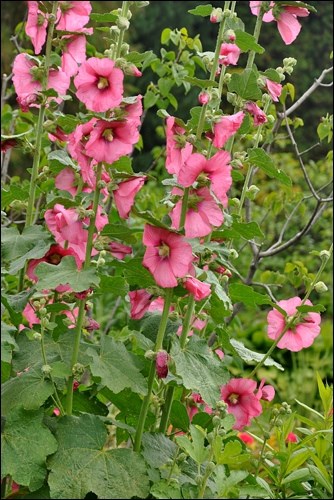A true biennial is a plant that takes two growing seasons to complete its lifecycle. During the first season, the seed germinates, typically forms a low rosette of leaves, stores up energy in a tap-root or thickened short stem at or just below the ground and then goes dormant in the late fall. The cool moist spring conditions trigger the next phase of the plant’s life cycle: reproduction. A flowing stalk elongates and towers over the overwintered rosette, eventually flowers and sets seeds in mid- to late summer. At this stage, the plant has completed its program and does not survive a third year. This strategy is not reserved just for ornamental plants; some of our vegetables are also biennials in more moderate climates such as carrots, beets, celery and cabbage.
Two biennials worth growing in your garden are foxglove and hollyhock.
In their first year, foxgloves (Digitalis purpurea) produce a short stem with soft green, slightly hairy long leaves. In their second year, a tall (45 – 120 centimetres) flowering stalk emerges and downward facing, thimble-sized, bell-shaped flowers opening up mid-summer. Flower colours include white, yellow, pink, rose, lavender and purple.
The inside of the flower features a large white spot mottled with crimson, burgundy or chocolate spots. Prairie winters may be too harsh for foxglove to survive to their flowering year. Mulching may improve their odds. The good news is that there is an annual cultivar, Foxy, that will flower in its first year. If growing from seed, Foxy should be started early (January) and set out as seedlings in May. You can also find Foxy in most larger garden centres as bedding plants. If you don’t mind a limited colour choice (pale butter-yellow flowers with a brown spotted interior), a hardy perennial foxglove (D. grandiflora or D. ambigua) exists. Flowering occurs in June, spikes can reach 100 centimetres. Of note is that foxgloves grow reliably in shade.
Hollyhock (Alcea rosea, syn. Althaea rosea) is considered an old-fashioned standby that is regaining popularity. It is truly a very tough plant. I have seen it growing completely unattended against a building on one side and a gravel parking lot on the other, rewarding all who go by with a blaze of late summer colour.
In the first year, a rosette of round, lobed medium green leaves is produced. The following summer, a very tall stalk, rises from the rosette, often reaching 150 – 240 centimetres, producing large (10 – 13 centimetre) saucer-shaped flowers over a two-month period starting in July. Flower colour can be white, pink, yellow, red and purple. Some cultivars are so dark purple to almost appear black.
There are also double flowered cultivars that resemble small pom-poms. Hollyhock plants may produce side shoots to survive and flower into the following year. Hollyhocks will also self-sow and, if left alone, will eventually produce a self-sustaining little colony that will bloom year after year.
A common hollyhock disease is leaf rust. The disease appears first as small round yellow-orange pustules on undersides of the lower leaves. On the top surface, larger orange spots with red centres soon appear. If left unchecked, the disease can quickly spread to other leaves and stems. To control, inspect and remove infected leaves as soon as they appear and dispose all debris in the fall – do not add to your compost. Rust rarely kills hollyhock outright, but it does cause premature yellowing and dieback in the fall. Fortunately, resistant cultivars are available (e.g. Happy Lights).
— This column is provided courtesy of the Saskatchewan Perennial Society (www.saskperennial.ca; [email protected]; NEW www.facebook.com/saskperennial). Check out our Bulletin Board or Calendar for upcoming garden information sessions, workshops and tours. Visit our booth at Gardenscape, April 8 – 10.




